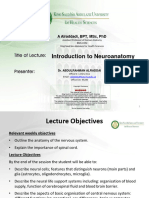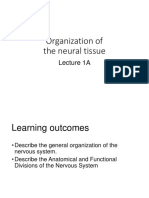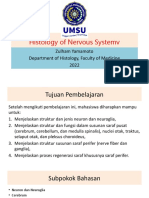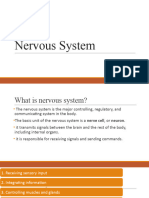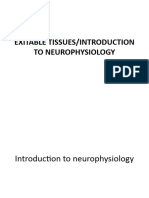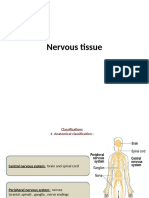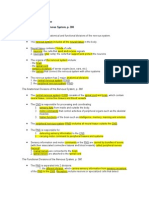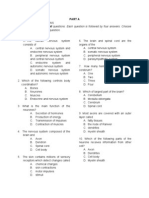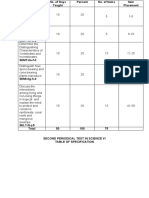0 ratings0% found this document useful (0 votes)
15 viewsHistology of Nervous Tissue: Dr. Marwa Gaffar Faki Ali M.B.B.S, M.Sc. Clinical Anatomy
Histology of Nervous Tissue: Dr. Marwa Gaffar Faki Ali M.B.B.S, M.Sc. Clinical Anatomy
Uploaded by
GhufranAbdulrahmanHistology cartilage flashcards quick review of general Histology exams alneelain university PowerPoint slides
Copyright:
© All Rights Reserved
Available Formats
Download as PPTX, PDF, TXT or read online from Scribd
Histology of Nervous Tissue: Dr. Marwa Gaffar Faki Ali M.B.B.S, M.Sc. Clinical Anatomy
Histology of Nervous Tissue: Dr. Marwa Gaffar Faki Ali M.B.B.S, M.Sc. Clinical Anatomy
Uploaded by
GhufranAbdulrahman0 ratings0% found this document useful (0 votes)
15 views21 pagesHistology cartilage flashcards quick review of general Histology exams alneelain university PowerPoint slides
Original Title
nervous
Copyright
© © All Rights Reserved
Available Formats
PPTX, PDF, TXT or read online from Scribd
Share this document
Did you find this document useful?
Is this content inappropriate?
Histology cartilage flashcards quick review of general Histology exams alneelain university PowerPoint slides
Copyright:
© All Rights Reserved
Available Formats
Download as PPTX, PDF, TXT or read online from Scribd
Download as pptx, pdf, or txt
0 ratings0% found this document useful (0 votes)
15 views21 pagesHistology of Nervous Tissue: Dr. Marwa Gaffar Faki Ali M.B.B.S, M.Sc. Clinical Anatomy
Histology of Nervous Tissue: Dr. Marwa Gaffar Faki Ali M.B.B.S, M.Sc. Clinical Anatomy
Uploaded by
GhufranAbdulrahmanHistology cartilage flashcards quick review of general Histology exams alneelain university PowerPoint slides
Copyright:
© All Rights Reserved
Available Formats
Download as PPTX, PDF, TXT or read online from Scribd
Download as pptx, pdf, or txt
You are on page 1of 21
Histology of nervous tissue
Dr. Marwa Gaffar Faki Ali
M.B.B.S, M.Sc. clinical anatomy
By the end of this session the student is able to:
• Identify the nervous tissue.
• Identify the different parts of the nervous tissue.
• Identify the neurons, their functions, different parts,
and types.
• Identify the synapses and its different types.
• Identify the supporting cells of the nervous tissue.
Introduction:
• The most complex system in the body.
• Nerve tissue is distributed throughout the body as an
integrated communications net work.
• Network of nerve cells (neurons) assisted by supporting
cells (glial cells).
Introduction:
Anatomically:
• CNS.
• PNS.
Functionally:
• Somatic NS.
• Visceral (autonomic) NS.
Neurons:
• The functional unit in both the CNS and PNS.
• Specialized for:
- Reception.
- Integration.
- Transformation.
- Transmission of information.
Neurons:
Components of Neuron:
• Cell body.
• Dendrites.
• Axon.
Neurons:
Cell body (perikaryon):
• Synthetic or trophic center for the entire neuron.
• Has large, euchromatic nucleus with a well-developed nucleolus.
Neurons:
Cell body (perikaryon):
• Contains Nissl bodies (large masses of free polysomes and RER).
• Golgi complex only in the cell body.
• Mitochondria scattered in cell body but are abundant in the axon
terminals.
• Neurofilaments (intermediate filaments) abundant in perikaryons
and cell processes.
Neurons:
Dendrites:
• short and divided like tree
branches.
• The principal signal reception and
processing sites on neurons.
• covered with many synapses.
• Dendritic spines are short blunt
structures projecting at points
along dendrites that serve as the
initial processing sites for synaptic
signals.
Neurons:
Axons:
• Fine cylindrical usually very long
process.
• Originate from the axon hillock
(pyramid- shaped region of the
perikaryon).
• The initial segment, is the site
of summation of excitatory and
inhibitory stimuli.
• Ends as terminal arborization
(distal end).
Neurons:
Types of neurons:
1. Unipolar (Pseudounipolar) Neurons:
• One single process.
• Sensory neurons of the PNS (spinal and cranial nerve
ganglia).
Neurons:
Types of neurons:
2. Bipolar Neurons:
• Two processes.
• Sensory neurons in the olfactory epithelium, the retina, and the inner
ear.
Neurons:
Types of neurons:
3. Multipolar Neurons:
• most common in the CNS.
• More than two processes.
• Numerous dendrites and one axon.
• Motor cells in anterior and lateral horns of the spinal cord,
autonomic ganglion cells).
Synapses:
• The sites of functional contact of a neuron with another
neuron, an effector cell (muscle, gland), or a sensory
receptor cell.
Supporting (glial) cells of the nervous tissue:
• Neuroglia in the CNS (oligodendrocytes, astrocytes,
ependymal cells & microglia).
• Schwann cells and satellite cells in the PNS.
Glial cells:
Oligodendrocytes:
• Predominant glial cells in CNS white matter.
• Wrap around parts of several axons, producing myelin
sheaths.
• Function: Myelin production, electrical Insulation.
Glial cells:
Astrocytes:
• most numerous, diverse structurally and functionally.
• Bind neurons to capillaries and to the pia mater .
- fibrous astrocytes (long processes) in white matter.
- Protoplasmic astrocytes (short branched processes) in gray matter.
• Function: Structural and metabolic support of neurons,BBB& repair
processes
Glial cells:
Ependymal cells:
• epithelial-like cells (columnar or cuboidal).
• Line the ventricles of the brain and central canal of
the spinal cord.
• Function: Aid production and movement of CSF.
Glial cells:
Microglial cells:
• Small cells with short irregular processes.
• In both gray and white matter.
• Phagocytic cells.
• Function: Defense and immune-related activities.
Glial cells:
• Schwann cells:
• Also called neurolemmocytes.
• Form myelin sheath around axons of PNS.
• Function: Myelin production, electrical
insulation.
Glial cells:
Satellite cells:
• Restricted to peripheral ganglia.
• Covering layer over the large neuronal cell bodies in
the ganglia of the PNS.
• Function: Structural and metabolic support for
neuronal cell bodies.
You might also like
- Netter Atlas of Human Neuroscience PDFDocument310 pagesNetter Atlas of Human Neuroscience PDFAndra Iordache75% (4)
- Biopsychology: Ninth EditionDocument24 pagesBiopsychology: Ninth EditionJasleen Kaur100% (2)
- Anatomy and Physiology of CVADocument4 pagesAnatomy and Physiology of CVAKimsha ConcepcionNo ratings yet
- Physiology of PainDocument23 pagesPhysiology of PainSarad Chand Yadav100% (3)
- Nervous Tissue System-92618Document151 pagesNervous Tissue System-92618gokulkrishnayadhavNo ratings yet
- Introduction To Excitable TissuesDocument26 pagesIntroduction To Excitable TissuesSohail KhanNo ratings yet
- Nervous System NAIHSDocument30 pagesNervous System NAIHSonline videoNo ratings yet
- Nerve TissueDocument48 pagesNerve Tissuefpmorante3596antNo ratings yet
- DR Jagdish Narayan Assistant Professor Department of PhysiologyDocument75 pagesDR Jagdish Narayan Assistant Professor Department of PhysiologyYordanos GetachewNo ratings yet
- Introduction Into The Nervous System 2017-18Document58 pagesIntroduction Into The Nervous System 2017-18maodNo ratings yet
- Overview of The Nervous System & Neurotransmission: Assoc. Prof Peter ShortlandDocument58 pagesOverview of The Nervous System & Neurotransmission: Assoc. Prof Peter Shortlandkenny013No ratings yet
- Nervous Tissue.: Dr. Zahid Mehmood DPT, MS-NMPTDocument25 pagesNervous Tissue.: Dr. Zahid Mehmood DPT, MS-NMPTZahid Mehmood100% (1)
- Unit 3 Nervous systemDocument97 pagesUnit 3 Nervous systemMuneeb RiazNo ratings yet
- Nerve - Muscle - Physiology 16 12 14Document75 pagesNerve - Muscle - Physiology 16 12 14deepalidangwal10No ratings yet
- The Nervous SystemDocument228 pagesThe Nervous Systemivypertet395No ratings yet
- L1 SBM Neuro 1Document88 pagesL1 SBM Neuro 1Sohil PatelNo ratings yet
- 2021 NSDocument296 pages2021 NSRachael RadleyNo ratings yet
- Nervous SystemDocument83 pagesNervous Systemsafwantatlay2004No ratings yet
- Physiology: Topic: Nerve Physiology Dr. Anu Baburaj P.VDocument26 pagesPhysiology: Topic: Nerve Physiology Dr. Anu Baburaj P.VNaya AagaazNo ratings yet
- Nervous TissueDocument35 pagesNervous TissuematharatradersNo ratings yet
- 3nerve Fiber-Converted 1Document49 pages3nerve Fiber-Converted 1tinashembofana84No ratings yet
- 11 Histology of The Nervous TissueDocument45 pages11 Histology of The Nervous TissueMartha Orendu Oche AttahNo ratings yet
- Chapter-3Nervous systemDocument123 pagesChapter-3Nervous systemEsubalew DelieNo ratings yet
- Nervous System 2022Document41 pagesNervous System 2022zahra nabilaNo ratings yet
- 10.nervous TissueDocument70 pages10.nervous TissueGenard Neil Credo Barrios100% (1)
- Nervous TissueDocument29 pagesNervous TissuepromiseakpovikeNo ratings yet
- nervous system-1Document74 pagesnervous system-1Rishabh SharmaNo ratings yet
- Nervous Tissue 4th Year 2020-2021 DR Mona1Document40 pagesNervous Tissue 4th Year 2020-2021 DR Mona1Atheer AltowairqiNo ratings yet
- UntitledDocument63 pagesUntitledWardah AliNo ratings yet
- Neurons and Their FunctionsDocument22 pagesNeurons and Their FunctionsBiruk YenewNo ratings yet
- Histology of Nervous Tissue and Medulla SpinalisDocument32 pagesHistology of Nervous Tissue and Medulla SpinalisSuhas Kapse100% (1)
- Tisu Neural Neurofisiologi Neuron Neuroglia Terminologi SarafDocument141 pagesTisu Neural Neurofisiologi Neuron Neuroglia Terminologi SarafRainne LeeNo ratings yet
- 1.physiology of Nervous System DR Hasnain Northwest Univerty PeshawarDocument27 pages1.physiology of Nervous System DR Hasnain Northwest Univerty PeshawarHasin's Queen100% (1)
- Nervous SystemDocument76 pagesNervous Systemrdxbeast777No ratings yet
- Nervous System - IDocument43 pagesNervous System - IChandni PNo ratings yet
- Learning Objectives 1. Brain and Spinal Cord.: Dr. Claudia M. Diaz Brain Lectures SummaryDocument12 pagesLearning Objectives 1. Brain and Spinal Cord.: Dr. Claudia M. Diaz Brain Lectures SummaryCarleta StanNo ratings yet
- Nervous 1Document53 pagesNervous 1allenjay.villar-21No ratings yet
- Neuroglial Cells and NeuronsDocument16 pagesNeuroglial Cells and NeuronsMalliga SundareshanNo ratings yet
- Exitable Tissues 2Document85 pagesExitable Tissues 2Asaju HadizaNo ratings yet
- Neuroanatomical and Neurophysiological Bases of Behavior LecDocument53 pagesNeuroanatomical and Neurophysiological Bases of Behavior Lecstephen allan ambalaNo ratings yet
- Nervous Tissue Study OutlineDocument2 pagesNervous Tissue Study Outlineannekerstine50No ratings yet
- 11 - Histology Lecture - Structure of Nervous TissueDocument50 pages11 - Histology Lecture - Structure of Nervous TissueAMIRA HELAYEL100% (1)
- CHAPTER 8 - Nervous SystemDocument25 pagesCHAPTER 8 - Nervous System20230027475No ratings yet
- NERVOUS TISSUE AND GANGLIADocument34 pagesNERVOUS TISSUE AND GANGLIAcasanovamike23No ratings yet
- Chapter 7 - NERVOUS SYSTEM PDFDocument58 pagesChapter 7 - NERVOUS SYSTEM PDFMary LimlinganNo ratings yet
- NeurochemistryDocument109 pagesNeurochemistryCharles OzochukwuNo ratings yet
- CELLULAR S OF NS Updated 29022024 123331pmDocument54 pagesCELLULAR S OF NS Updated 29022024 123331pmaz.rah.e.khudiNo ratings yet
- 2. PHYSIO FULL NOTEDocument60 pages2. PHYSIO FULL NOTEmomireemaot7No ratings yet
- 8.1 Organisation of Nervous System & Nerve CellsDocument71 pages8.1 Organisation of Nervous System & Nerve Cells5kj9ysmf24No ratings yet
- Neurophysiology - Copy_031655Document198 pagesNeurophysiology - Copy_031655abbasbelkoaishaNo ratings yet
- Nervous System Till ClassificationDocument34 pagesNervous System Till ClassificationMuhammad Ibtsam - PharmDNo ratings yet
- Brain Theory & Neural NetworkDocument112 pagesBrain Theory & Neural NetworkSaikat MondalNo ratings yet
- H 1.1 Histologi Jaringan Dan Sistem Saraf (Nervous System)Document32 pagesH 1.1 Histologi Jaringan Dan Sistem Saraf (Nervous System)Rahel Pasha SilitongaNo ratings yet
- Neurohistochemistry IDocument53 pagesNeurohistochemistry IJACOB ZANUNo ratings yet
- The Nervous System Functions of The Nervous System: © 2018 Pearson Education, Ltd. 1Document20 pagesThe Nervous System Functions of The Nervous System: © 2018 Pearson Education, Ltd. 1Ash alejoNo ratings yet
- Fisiologi Manusia: DR Mellova Amir MSCDocument52 pagesFisiologi Manusia: DR Mellova Amir MSCRizal adhitya100% (1)
- Nervous TissueDocument40 pagesNervous TissueAbdo KhalafNo ratings yet
- BioPsy Week 2Document16 pagesBioPsy Week 2ayşe tankırNo ratings yet
- Overview of Nervous Tissue Along With Related StructureDocument50 pagesOverview of Nervous Tissue Along With Related StructureNarayan GhimireNo ratings yet
- Nervous SystemDocument26 pagesNervous SystemgithusidneyNo ratings yet
- Nervous SystemDocument6 pagesNervous SystemGracielle Angelyka PeraltaNo ratings yet
- Unit 3 Nervous System Part 1Document62 pagesUnit 3 Nervous System Part 1Shehzad Haider100% (1)
- K1-Nerve Tissue & Nervous System (Histologi)Document40 pagesK1-Nerve Tissue & Nervous System (Histologi)Perisha Veera100% (1)
- Document 1Document127 pagesDocument 1Samsam AliNo ratings yet
- Jescspsu 08Document11 pagesJescspsu 08Alok RanjanNo ratings yet
- Reviews: The Enteric Nervous System and NeurogastroenterologyDocument9 pagesReviews: The Enteric Nervous System and NeurogastroenterologywizaanjosNo ratings yet
- Content ServerDocument7 pagesContent ServerMaria Fernanda AlmanzaNo ratings yet
- Jo Gibson Handout PDFDocument14 pagesJo Gibson Handout PDFgemichan26No ratings yet
- CNS PNS: Lipofuscin: Wear and TearDocument10 pagesCNS PNS: Lipofuscin: Wear and TearDr P N N ReddyNo ratings yet
- Chapter 12 Neural TissueDocument15 pagesChapter 12 Neural TissueKatherine De San AgustinNo ratings yet
- Editorial: Etiological Diagnostic Tools To Elucidate Isolated' VentriculomegalyDocument11 pagesEditorial: Etiological Diagnostic Tools To Elucidate Isolated' Ventriculomegaly5206329No ratings yet
- Exercise No. 7 Nervous TissueDocument10 pagesExercise No. 7 Nervous TissueRyan Aaron Cruz ParNo ratings yet
- Speech PhysiologyDocument41 pagesSpeech PhysiologyMudassar RoomiNo ratings yet
- AnatomyfdswgsdfgsdfgDocument5 pagesAnatomyfdswgsdfgsdfgNikka Moreen DagdagNo ratings yet
- Im Case Study 04Document49 pagesIm Case Study 04Shaine BalverdeNo ratings yet
- A Short Course in Mathematical Neuroscience (Revised 7/2015)Document216 pagesA Short Course in Mathematical Neuroscience (Revised 7/2015)Lucas Marchetti BragaNo ratings yet
- The Structure of The Nervous SystemDocument4 pagesThe Structure of The Nervous SystemThelNo ratings yet
- Formative Test Science Form 4Document7 pagesFormative Test Science Form 4Sasmuhd Hamzah100% (2)
- Neural Integration I: Sensory Pathways and The Somatic Nervous System PDFDocument4 pagesNeural Integration I: Sensory Pathways and The Somatic Nervous System PDFAmandaNo ratings yet
- PT - Science 6 - Q2Document9 pagesPT - Science 6 - Q2CYRUS ANDREA AGCONOLNo ratings yet
- Aphasia Notes by Dr. Santhosh (PW Med Ed)Document4 pagesAphasia Notes by Dr. Santhosh (PW Med Ed)Stella ParkerNo ratings yet
- Nervous System Ear and Eye-1Document52 pagesNervous System Ear and Eye-1srzvzvt7rzNo ratings yet
- NUR 4717CCalendarMoUsethis (9) OutlineDocument17 pagesNUR 4717CCalendarMoUsethis (9) OutlineSomie Jr. SanchezNo ratings yet
- Neural Control and Coordination - Shobhit NirwanDocument14 pagesNeural Control and Coordination - Shobhit NirwanSWASTIKA MALONo ratings yet
- Neuroasia 2017 22 (3) 185Document7 pagesNeuroasia 2017 22 (3) 185Ray ParikesitNo ratings yet
- Nervous System (Fundamental & Central Questions)Document13 pagesNervous System (Fundamental & Central Questions)Mohammed Morsy AlsherifNo ratings yet
- Full Download Neural Regeneration 1st Edition Kwok-Fai So PDF DOCXDocument43 pagesFull Download Neural Regeneration 1st Edition Kwok-Fai So PDF DOCXpeilbades100% (1)
- 1.physiology of Nervous System DR Hasnain Northwest Univerty PeshawarDocument27 pages1.physiology of Nervous System DR Hasnain Northwest Univerty PeshawarHasin's Queen100% (1)
- 8th - Science - Notes Complete Book PDFDocument21 pages8th - Science - Notes Complete Book PDFbszool006No ratings yet









